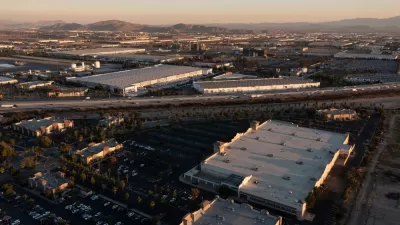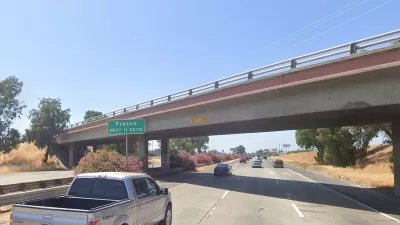Today’s massive modern distribution centers have outsized impacts on adjacent neighborhoods. But outdated zoning codes often let them slip through the cracks with no environmental review.

New York City’s zoning code isn’t written for modern warehouse facilities, according to an article in Next City by María Paula Rubiano A., letting companies like Amazon build massive facilities with little or no environmental oversight. “At the time the zoning code was written, it was a fairly accurate assessment. Warehouses in the ’60s were generally used to store things before they arrived at retailers. Freight came and went at certain hours, and the buildings were relatively small, standing, on average, less than 30 feet, or two stories tall. ”
Today, however, warehouses are “creatures of an entirely new logistics system,” bigger and taller than ever before. “Some estimates calculate that modern warehouses can bring around 1,000 additional daily truck trips to a surrounding neighborhood. The presence of these extra vehicles can worsen local air quality, upping the risk of asthma, heart attacks, and premature deaths.”
But according to the city’s zoning code, “Last-mile facilities built today still fall under the 1961 definition of a warehouse,” triggering no environmental requirements. This doesn’t just happen in New York City: “The United States is the only industrialized country without a national, standardized zoning code — meaning that there’s no universal definition of what a modern warehouse is, how hazardous it should be considered, and where it should be placed.”
Environmental justice advocates warn that not updating environmental regulations for distribution centers perpetuates historic injustice. “A recent investigation by Consumer Reports and The Guardian found that Amazon, which opened more fulfillment centers in 2020 than in the four years prior combined, has placed 69 percent of all its facilities in neighborhoods with a greater percentage of people of color.”
But zoning changes alone won’t protect public health from existing facilities. To mitigate the effects of air pollution on neighborhoods near fulfillment centers, “Last May, California’s South Coast Air Quality Management District approved the first legislation in the country regulating the indirect sources of pollution — trucks and cars — generated by the giant warehouse facilities.”
This set of regulations could serve as a model for holding warehouse builders accountable for environmental impacts.
FULL STORY: A ‘Warehouse’ by Any Other Name

Manufactured Crisis: Losing the Nation’s Largest Source of Unsubsidized Affordable Housing
Manufactured housing communities have long been an affordable housing option for millions of people living in the U.S., but that affordability is disappearing rapidly. How did we get here?

Americans May Be Stuck — But Why?
Americans are moving a lot less than they once did, and that is a problem. While Yoni Applebaum, in his highly-publicized article Stuck, gets the reasons badly wrong, it's still important to ask: why are we moving so much less than before?

Research Shows More Roads = More Driving
A national study shows, once again, that increasing road supply induces additional vehicle travel, particularly over the long run.

Judge Halts Enforcement of Anti-Homeless Laws in Grants Pass
The Oregon city will be barred from enforcing two ordinances that prosecute unhoused residents until it increases capacity and accessibility at designated camping sites.

Advancing Sustainability in Los Angeles County Schools
The Los Angeles County Office of Education’s Green Schools Symposium brings together educators, students, and experts to advance sustainability in schools through innovative design, climate resilience strategies, and collaborative learning.

Using Old Oil and Gas Wells for Green Energy Storage
Penn State researchers have found that repurposing abandoned oil and gas wells for geothermal-assisted compressed-air energy storage can boost efficiency, reduce environmental risks, and support clean energy and job transitions.
Urban Design for Planners 1: Software Tools
This six-course series explores essential urban design concepts using open source software and equips planners with the tools they need to participate fully in the urban design process.
Planning for Universal Design
Learn the tools for implementing Universal Design in planning regulations.
City of Moreno Valley
Institute for Housing and Urban Development Studies (IHS)
City of Grandview
Harvard GSD Executive Education
NYU Wagner Graduate School of Public Service
City of Cambridge, Maryland
Newport County Development Council: Connect Greater Newport





























